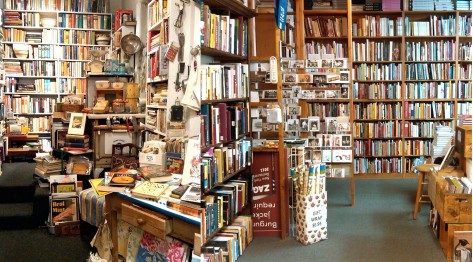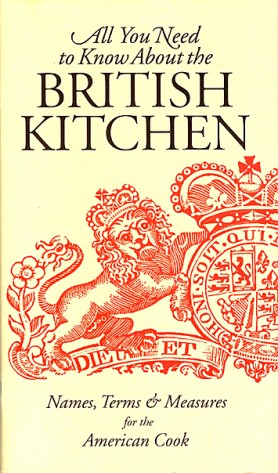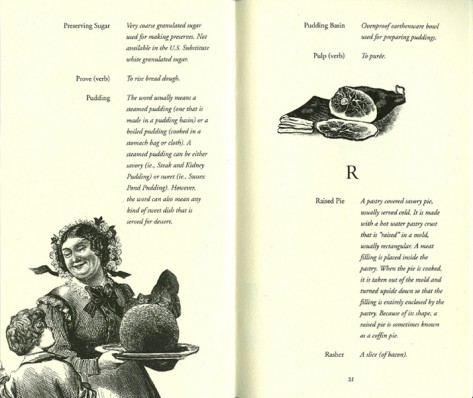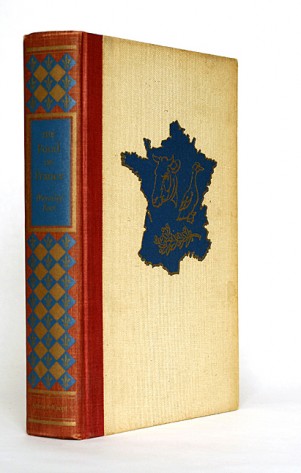Bookstores for Food Lovers
This past fall I took a trip down to New York City to visit friends, have design talks with Noboru (the designer of this blog), eat some good food, and poke around the city.
The eating highlight was the pork buns at Momofuku in the East Village. They live up to their reputation. Eating them was a sacred experience—the buns call upon one to slow down and be mindful, with each bite, of their nuanced flavor and texture. (I mean it, man.) I found them—and the passion for quality that they represent—inspiring. (FYI, there is a recipe for them in David Chang’s book Momofuku.)
The poking highlight was visiting two niche bookstores devoted entirely to selling cookbooks and books on food: Kitchen Arts & Letters, located in the Upper East Side, and Bonnie Slotnick Cookbooks, in Greenwich Village. I’d been to Kitchen Arts & Letters, owned by Nach Waxman, but had never ventured into Bonnie Slotnick’s store. Both shops are wonderful, each having its own focus and flavor.

Bonnie Slotnick Cookbooks (left) and Kitchen Arts & Letters (right)
Nach Waxman and Bonnie Slotnick spent a generous amount of time talking with me about their bookstores and the business of selling books. A shared theme in my conversations with both Nach and Bonnie is the important role the brick-and-mortar bookshop plays in building relationships between booksellers and shoppers, and even among shoppers—what some might call “good customer service” and “building community.” Whereas the first sounds like hardtack business strategy and the latter, altruistic, they are, as I think both Nach and Bonnie would agree, incredibly interlinked.
Kitchen Arts & Letters
Nach opened his store in 1983, after working as an editor in a New York publishing house. Though he knew he didn’t want to open a general bookstore—the idea of focusing on one subject that he could master was more appealing—he hadn’t initially settled on exactly what niche market he should serve. He ruled out several subjects, such as sports, biography, and history, before settling on food and cooking. It’s a personal love, and he realized it’s a subject that engages everyone, professional and nonprofessionals alike.
From the very beginning he wanted his store to take a broad view of food and the cultural role it plays in our lives. The inventory reflects his anthropological approach: only about half of the books on the shelves are cookbooks—that is, books with recipes—the rest are more rightly called “food studies” books, ranging from the subjects of food in literature to food in art, social life, and so on.
Though Kitchen Arts & Letters will do searches for out-of-print books for customers (and keeps an inventory of 3,000 out-of-print books in the basement), they are in the business of selling books in print, and all of the books you see on their shelves are in print.
About 40 percent of the inventory at Kitchen Arts & Letters is published overseas, in English and foreign languages. This enables Nach to help his customers, particularly chefs, keep up with new culinary trends that may have their roots outside the United States and/or that American publishers are slow to publish on. (He sees American publishers as being conservative compared to their counterparts elsewhere.) To help American customers make sense of Imperial measurements in British cookery titles, Kitchen Arts & Letters has printed a lovely pamphlet written by Jane Garmey, available for sale at the store, called All You Need to Know About the British Kitchen.

 Besides this pamphlet, you will find few other non-book items in the store—some postcards, food-themed wrapping paper during the holiday season, a limited selection of food guides and magazines, and an olive oil that Nach loves and can’t find elsewhere in New York. The total amount of the non-book inventory is only about 3 percent; this is purposeful and part of Nach’s original plans—he wanted a virtually “chatzka”-free store.
Besides this pamphlet, you will find few other non-book items in the store—some postcards, food-themed wrapping paper during the holiday season, a limited selection of food guides and magazines, and an olive oil that Nach loves and can’t find elsewhere in New York. The total amount of the non-book inventory is only about 3 percent; this is purposeful and part of Nach’s original plans—he wanted a virtually “chatzka”-free store.
Book orders can be placed over the phone, but Nach much prefers customers to come into the store. That gives him, he said, and the other staff at the store, “. . . a chance to size up customers and better suggest the right book for them.” When customers are looking for a cookbook for a particular cuisine—say Italian—he always asks them what they will be using the book for. They may be a home cook looking for red sauce recipes for family meals, or they may be a chef looking for new inspiration or wanting to explore a lesser-known regional cuisine. Learning about customers’ knowledge and experience with food, and their interests, all play a part in helping him recommend the right book for them. When I mentioned to him that I love French food, and was looking for some memoir-style books with recipes for the club, he picked On Rue Tatin off the shelf for me. It’s going to be one of the choices for the next cookbook pick. (It’s a good read; I started into it and then had to stop myself from getting too far into it so that I could save it, and my enjoyment of it, for the club.)
Nach referred to his shop as a “yaky” place, where customers come to discuss books, food, and cooking. He views his customers as a resource for the shop, and vice versa. (He has learned about books, chefs, and food traditions from customers.) He enjoys the opportunity to lead people down new food and cooking paths, but “The real reason we do it,” he said, “is to have fun. You don’t run a bookstore because it’s a particularly good way to make a living.”
When cooking at home for his pleasure, his food of choice is Indian. Of course, I had to ask him what Indian cookbook he recommends, if one is looking for a comprehensive, overview of the cuisine. His answer: Classic Indian Cookingby Julie Sahni. Once DCCC members are in the mood to cook Indian food again—we’ve only just finished cooking from another Indian cookbook—it will be on the list of picks.
Ironically, for someone in the business of selling cookbooks, Nach doesn’t recommend following recipes—at least, not slavishly and not after becoming familiar with a cuisine or cooking method. When he prepares Indian food, he doesn’t follow recipes from Sahni’s book, or any other Indian cookbook; he’s been cooking Indian food for so many years that at this point he uses Indian cookbooks for reference only. In fact, this is how he advises people to use recipes—as a reference or springboard rather than a rigid script. He feels it’s the only way people will learn to cook. He suggests reading a recipe a couple of times, closing the book, and then cooking from memory. (I like this idea, but I don’t think I would have the confidence to close the book before measuring or weighing all of the ingredients.)
One reason, he states, that people must be able to deviate from a recipe are the number of variables inherent in cooking: the ingredients (is the tomato you’re using particularly ripe and juicy, or the opposite?); equipment (how conductive are your pots and pans, and are they heavy bottomed, or not?); stove (it is gas, electric, or induction? does your oven run hot or cool?); weather (it is hot or cold out? dry or humid?); and even the cook’s mood! No published recipe, he stressed, could ever give enough information to account for all these possible variables.
Naturally Nach is passionate about books and, despite the pressures free content on the Internet has placed on book publishing, he is optimistic about the future. He feels that as long as publishers continue to publish books, people will buy them. He thinks books have an inherent value over using the Internet: You can surf the net to find individual bits of information here and there, but it is in books that you can find a directed, focused, and comprehensive approach to a subject.
When in New York:
Kitchen Arts & Letters
1435 Lexington Avenue
(btwn 93rd and 94th Streets)
Ph: 212-876-5550
Hrs: Mon, 1–6:00; Tues–Fri, 10–6:00; Sat, 11–6:00
Bonnie Slotnick Cookbooks
At Bonnie Slotnick Cookbooks, Bonnie is in the business of selling out-of-print books, some of which are quite rare. The oldest book she had in her inventory when I visited was from 1823, and titled like so:
The American
domestic cookery
by
a lady
I found a cloth-bound first edition of The Food of Franceby Waverly Root, an often-quoted writer who I’ve never read (perfect opportunity, I thought). The book is organized regionally by fat: The Domaine of Butter, The Domaine of Fat, The Domaine of Oil, and finally, “The Pyrenees,” which uses all three. Who could resist that?

 Unlike in-print books, which have a list price set by the publisher, the price of out-of-print books can vary greatly, depending on their condition and perceived value. Most of the books in Bonnie’s shop are priced between $20 and $30. When setting prices, Bonnie aims for a price that a new book of comparable quality goes for. She particularly likes the price point of $22, which she feels shows some respect for the author and the book, but is affordable for most people.
Unlike in-print books, which have a list price set by the publisher, the price of out-of-print books can vary greatly, depending on their condition and perceived value. Most of the books in Bonnie’s shop are priced between $20 and $30. When setting prices, Bonnie aims for a price that a new book of comparable quality goes for. She particularly likes the price point of $22, which she feels shows some respect for the author and the book, but is affordable for most people.
Bonnie likes the idea of offering something that people can’t get elsewhere. And she’s sentimental about books—especially those passed down and with a story. Books can hold a place in people’s hearts, she said, after years of use. You won’t be able to say that about a Kindle, she added.
In fact, she sometimes receives calls from people who, on the verge of tears, want to sell her an old book that turns out to be a family keepsake. Often she’ll convince them to hold onto the book.
She opened her shop in 1997, in a different location. Before becoming a bookseller, she had been an editor/writer for a small publishing company, and had gained experience in the used and rare book business as the “out-of-print” person at Kitchen Arts & Letters.
One of the things that Bonnie enjoys most about running a bookstore is the chance to help someone find the just-right book. The reasons for buying a book, and the types of people who walk into her store, vary widely: There are those who look for appealing, workable recipes and head straight home to cook, and others who enjoy reading cookbooks—the introduction, recipes, headnotes, sidebars and all—but don’t cook very much. And some customers are drawn to volumes of food history, culinary sociology, or memoirs—books that contain no recipes at all.
Over the years Bonnie has learned that just because customers don’t cook, or may not cook from books, doesn’t mean they’ll walk out of the shop empty-handed. For example, she may get a shopper looking for a gift; a writer working on a novel set in medieval France who wants to include historically accurate descriptions of her characters’ meals; a food historian who wants to know how a certain recipe has evolved; a book designer looking for inspiration—something with the look of the thirties or the sixties, perhaps, or examples of how cookbooks were illustrated and how recipes were laid out in the past. (After I told the designer of this blog about Bonnie Slotnick’s shop, he spent some time there getting ideas for the banner art, with Bonnie’s help.) And some people come into the store to purchase books as an investment, with an eye toward their appreciation. “What’s collectible?” they ask. Bonnie always tells them to buy what they love, without considering their resale value.
Bonnie told me about a whole nother market for older books—shall we say antique or vintage—that I had never considered: books that are purchased for their visual/object appeal alone, regardless of their content, for theater, movie or TV-show sets or for décor in homes or other settings. Most recently, she supplied a lot of the books for the movie Julie and Julia, and then bought them back (along with boxes of wonderful non-book props). And she sold twenty or thirty mid-century books to the props department for the television show Gilmore Girls.
Some customers will make book purchasing decisions based on the spatial demands of the area they want to fill with books. For example, once she had a customer with a 6-inch-high bookshelf and needed books to fit in it. The woman didn’t care about the books’ content—they just had to fit the shelf. And another customer had space for books on top of her kitchen cabinets, below a very high ceiling. So she wanted very tall books.
Because the point of DCCC is to actually read and cook from what’s between the covers of books, rather than have them just adorn coffee tables, I was curious to know what Bonnie values in cookbook writers. The most important thing, she feels, is for a writer to have a distinct authorial voice. She likes to get a sense of who the author is. If you don’t know someone, she asked, how can you trust them? And she prefers writers who put recipes into context by including introductory material and headnotes—recipes don’t exist in a vacuum, after all!
In addition to books, Bonnie sells an eclectic variety of food-themed objects: antique whisks, vintage postcards, charming old tablecloths. (I bought a couple of tablecloths, one of which, with its meander pattern, is featured in some food photos I’ve taken for the current DCCC pick: The Food and Wine of Greece.)
She views these extra-book items, rich in texture and atmosphere, and the element of chance meetings and conversations, as significant advantages over the more sensory limited experience of shopping online, which strikes Bonnie as sadly isolating.
She has noticed that the walls of her bookstore serve as an introduction—people will comfortably start talking with one another without feeling they need a formal introduction. When hearing a customer’s question about cooking or a cookbook, other customers will often pipe up and share their own ideas and preferences.
Though Internet sales of out-of-print books have cut into her profit margin, she feels she still has a distinct benefit to offer: the experience of shopping (and browsing) in a bookstore. As long as customers continue to value that experience, she thinks she’ll continue to be in business.
When in New York:
Bonnie Slotnick Cookbooks
163 West Tenth Street
ph: 212-989-8962
Hrs: The shop is usually open from 1–7 pm six days a week (the day the shop is closed VARIES from week to week). Bonnie asks that you please call ahead to check for weekly variations in her hours, or to make an appointment for a time convenient for you.
